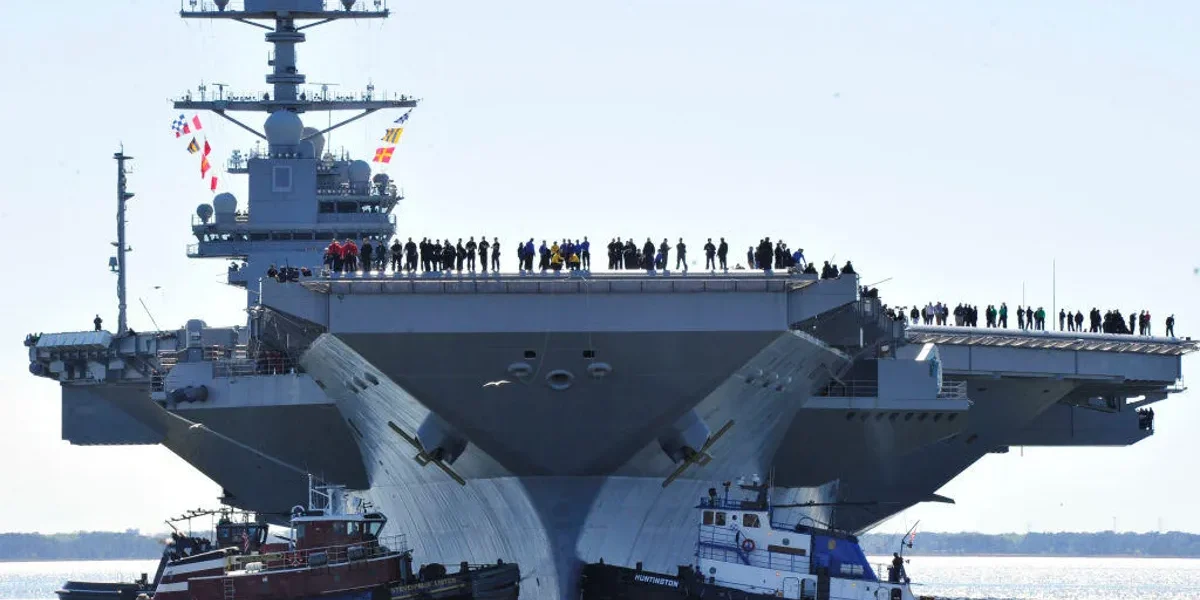The most advanced technological warship ever built is the USS Gerald R. Ford (CVN 78).

The Gerald R. Ford was launched from the dry dock into Virginia’s James River in November 2013 to begin its trials.
On July 22, 2017, the USS Gerald Ford was commissioned in Norfolk, Virginia. Commissioning is an extravagant occasion that puts a ship into active service. It is rooted in naval tradition.
Though President Trump has previously criticized the ship, he struck a much more optimistic tone during the ship’s commissioning celebration.
“American hands and steel built a 100,000-ton message to the entire world: American might is unparalleled,” he said.
Notwithstanding being officially commissioned, the Ford will involve a further four years of trials before operation. It will add a further $780 million to the ship’s already significant cost.
The completed carrier is 1,106 feet long and 250 feet tall.
The finished USS Gerald R. Ford provides a number of welcome quality-of-life updates for sailors over the prior Nimitz design, such as quieter sleeping quarters, various recreation areas, and gymnasiums in addition to better air conditioning.
The Ford alone will cost US taxpayers $12.8 billion in both labor and materials. This excludes the $4.7 billion spent on research and development for the new carrier class.
The term “responsibility” refers to the act of determining whether or not a person is responsible for his or her own actions.
It is the first US carrier to also be constructed using such digitalized strategies.
On the Ford, augmented reality is being used.
The Gerald R. Ford also employs augmented-reality technology to provide its crew with more information about the ship’s systems and to improve efficiency
The first cut of steel
The construction of a 90,000-ton naval vessel always starts with a single cut.
According to Newport News Shipbuilding, just welding the ship together will require 4,000,000 pounds of metal.
Working on the propellers
The propellers will enable the new class of ships to travel at speeds of 35 miles per hour, which is impressive for a 22.5-million-pound sea vessel.
The US Navy’s most advanced warship – and the world’s largest – created a stir this week as it set sail for its first deployment, a watershed moment in an ambitious plan to modernize the American fleet of aircraft carriers that have dogged by delays and technical hiccups.
The USS Gerald R Ford departed for Norfolk, Virginia, the world’s largest naval base, to join vessels from France, Germany, and Sweden for different exercises in the Atlantic.
The exercises will take place in the Atlantic and Mediterranean seas, where Russian fleets have already been operating in recent months in response to Ukraine’s invasion.
The nearly 100,000-ton ship, which cost the US government $13 billion, is hailed as possessing the potential to revolutionize the US Navy for several decades to come.
What folks know about the US Navy’s first-of-its-kind supercarrier
The USS Gerald R Ford is the first ship in the Ford class, that will include at least 3 other ships in various stages of construction.
Assembled by Huntington Ingalls Industries Newport News Shipbuilding, the boat weighs approximately 97,000 tons and is nuclear-powered.
It brags about using augmented-reality technology, which will provide the army with greater insight into the ship’s systems and increase efficiency.
The USS Gerald R Ford has not had an easy ride, as it has been chastised by Mr. Trump, other politicians, and navy veterans for problems including technical integration problems with the weapons elevators, misfires in the electromagnetic catapult, as well as a number of other issues over the years.
The US Navy’s most advanced warship – and the world’s biggest – generated a commotion because it set sail for its first deployment, a breakthrough for an ambitious project to modernize the American fleet of aircraft carriers which has now faced criticism amid delays and technical mishaps.
For more than 40 years ever since the 1970s, Nimitz-class carriers have served as the first responders throughout situations of crisis and dispute for the US Navy.
The Gerald R Ford has two nuclear reactors with 4 shafts, enabling it to make the journey at a rate of more than 30 knots. Its top speed is faster than that of the Royal Navy’s flagship, the HMS Queen Elizabeth, which can reach speeds of up to 25 knots.
Because of its high levels of automation, the ship does not require a large crew to operate and can function with a small unit.
It can transport over 4,539 personnel as well as 75 aircraft and other types of equipment.
According to the Navy, the carrier has nearly three times the amount of electrical power” as the previous Nimitz-class carriers.
Since its commissioning, the vessel has sailed for 250 to 300 days in testing at sea, but it only made its first formal deployment on Wednesday. Carrier Air Wing 8 has been working with the carrier off the coast of the United States.
The carrier has an electromagnetic launch system, or EMALS, which uses electricity to launch planes from it. A steam slingshot system was previously used. The new system means that the carrier will be under less stress, and the period between launches will be shorter.






